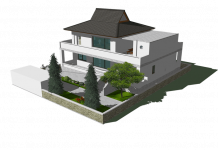In the rapidly evolving world of interior design, the right home design software can make all the difference. With myriad options available in 2023, it's crucial to understand which tools stand out in the crowd.
This article dives deep into the top 5 platforms, offering insights to equip you with the knowledge to choose wisely. Whether you're a professional or just embarking on a personal project, this review promises clarity.
Why Home Design Tools Matter?
In the current era, the use of home design software has become indispensable. These tools offer a practical approach to visualizing spaces before making real-world changes.
With their assistance, costly errors can be avoided, ensuring designs align with one's vision. They have become an essential ally, whether for professionals in the field or individuals redesigning their homes.
Moreover, they provide a platform to explore creativity without physical constraints. Ultimately, these digital platforms pave the way for more innovative and efficient design processes.
A Look at Leading Design Platforms in 2023
As we delve into 2023, selecting the right design tool becomes pivotal for achieving impeccable outcomes. With the many platforms available, discerning the best home design software can be Challenging.
EASYHOME STYLER
Standing as one of the forerunners in the design realm, it has captured the attention of many professionals and enthusiasts alike. It's tailored to cater to various design needs, offering both simplicity and advanced functionalities.
They are recognized for their user-friendly interface and adaptability. Designed to bring concepts to life, this tool allows users to visualize and tweak their designs effortlessly.
It's not just for seasoned professionals; even novices find it approachable. Its versatility makes it suitable for various design projects and ambitions.
Features
EASYHOME STYLER is packed with unique features that set it apart. Users can enjoy its 3D visualization capabilities, making design interpretation a breeze.
The drag-and-drop functionality ensures ease of use, and the extensive library offers myriad elements to incorporate into designs. These features make it a robust and intuitive tool in the design domain.
Pros and Cons
Like all design platforms, they come with strengths and areas for improvement. Here's a concise breakdown:
Pros:
- Intuitive user interface.
- Extensive design library.
- Flexible pricing models.
- Strong customer support.
Cons:
- It might be overwhelming for absolute beginners.
- Requires a stable internet connection for optimal performance.
- Limited offline capabilities.
- More extensive projects might experience a slight lag.
SketchUp: A Quick Dive
SketchUp, initially released in 2000, quickly became a household name in the design community. It started as a general-purpose 3D modeling tool but soon carved its niche in architectural visualization.
Over the years, its evolution and improvements have solidified its position as a preferred design platform for many.
Key Features
SketchUp is known for its intuitive interface and the ease it brings to 3D modeling. Users can draw and push/pull objects to bring their designs to life.
It boasts a vast component library, allowing for quick object placement. Its real-time shadows and texture mapping enhance the overall design experience.
Advantages and Drawbacks
No tool is without its pros and cons. Let's weigh SketchUp's strengths against its limitations:
Pros:
- User-friendly interface is suitable for beginners and professionals.
- Rich component library for varied design needs.
- Strong community support with numerous plugins available.
- Efficient geo-location and site modeling features.
Cons:
- Might experience performance issues with highly complex models.
- Advanced rendering requires additional plugins.
- Limited features in the free version.
- Some learning curve for advanced functionalities.
SketchUp: A Quick Dive
SketchUp, initially released in 2000, quickly became a household name in the design community. It started as a general-purpose 3D modeling tool but soon carved its niche in architectural visualization.
Over the years, its evolution and improvements have solidified its position as a preferred design platform for many.
Key Elements
SketchUp is known for its intuitive interface and the ease it brings to 3D modeling. Users can draw and push/pull objects to bring their designs to life.
It boasts a vast component library, allowing for quick object placement. Its real-time shadows and texture mapping enhance the overall design experience.
Advantages and Drawbacks
No tool is without its pros and cons. Let's weigh SketchUp's strengths against its limitations:
Pros:
- User-friendly interface suitable for beginners and professionals.
- Rich component library for varied design needs.
- Strong community support with numerous plugins available.
- Efficient geo-location and site modeling features.
Cons:
- Might experience performance issues with highly complex models.
- Advanced rendering requires additional plugins.
- Limited features in the free version.
- Some learning curve for advanced functionalities.
Room Sketcher
Room Sketcher is a design tool primarily catering to homeowners and professionals looking to plan and visualize indoor spaces.
As a go-to platform, it streamlines the process of space planning and decoration process. With a strong emphasis on interiors, it aims to transform ideas into tangible visuals to guide the design process.
Distinct Tools
Among Room Sketcher's standout offerings are its drag-and-drop interfaces that simplify design. The software provides 2D and 3D floor plans and furniture and decor placement capabilities.
Moreover, the virtual tours allow for an immersive exploration of designs. It's these interactive elements and user-friendly controls that define the software.
Pros and Shortcomings
As with all tools, Room Sketcher has its highs and lows. Here's a brief rundown:
Pros:
- The intuitive interface is ideal for beginners.
- Detailed 2D and 3D floor plan capabilities.
- Virtual tours for interactive design visualization.
- A comprehensive library of furniture and decor items.
Cons:
- Limited advanced tools for professional architects.
- Virtual tours might require a robust system for seamless operation.
- Some features are locked behind the premium version.
- Customization options might be limited compared to specialized software.
AutoCAD Architecture
AutoCAD Architecture is a derivative of the well-known AutoCAD, tailored explicitly for architects. It's an industry standard, cementing its place due to its precision and comprehensive toolset.
Its presence has influenced architectural workflows, making complex designs more manageable and precise.
Key Utilities
This tool stands out with its object-based design environment, streamlining architectural drafting. The software boasts specialized building design tools which facilitate the creation of floor plans, sections, and elevations.
Furthermore, it offers automated functions for building elements, providing consistency and efficiency in design.
Strengths and Drawbacks
While renowned, AutoCAD Architecture has its share of advantages and areas of improvement. Here's a brief:
Pros:
- Industry-standard software for architectural design.
- Precision and detailed drafting capabilities.
- Automated functions for consistent architectural elements.
- Integration with other Autodesk products for extended functionality.
Cons:
- The steeper learning curve, especially for beginners.
- It might be overkill for simple residential projects.
- Relatively higher pricing compared to other solutions.
- Requires a robust system for optimal performance.
Mastering Home Design Platforms
Maximizing the potential of design tools requires understanding universal techniques. First, always start with a clear plan and objective.
Detailed measurements are crucial; always verify them. Regularly save your work, and explore tutorials or community forums to leverage the total capacity of your chosen platform.
Software-Specific Strategies
Different platforms have unique quirks. For instance, in SketchUp, using layers can keep designs organized.
AutoCAD Architecture benefits from the consistent use of its automated functions for uniformity. Always dive deep into the specialized features of a tool and stay updated with its latest updates or plugins.
Choosing What's Right for You
Picking the right tool isn't a one-size-fits-all scenario. Here are aspects to ponder:
- Purpose: Is it for professional projects or personal use?
- Budget: How much are you willing to invest?
- Features: What specific tools or functionalities are must-haves?
- Compatibility: Does it align with your hardware or other software?
- Support: What kind of customer support or community backing does it have?
Assessing Your Needs
Your choice should mirror your requirements. Consider the following:
- Skill Level: Are you a beginner or a seasoned professional?
- Project Scale: Designing a room or an entire building?
- Frequency of Use: Daily, occasionally, or once in a blue moon?
- Collaboration: Do you need tools for team collaboration or client presentations?
Wrapping Up: The Home Design Software Landscape in 2023
As we close out our review, it's evident that 2023 offers a robust selection of home design software tailored for varied needs. From beginners to professionals, there's a tool for everyone.
Each platform has unique strengths and challenges. Making an informed choice requires a blend of research and personal assessment. Remember, the best software is the one that aligns with your goals.







